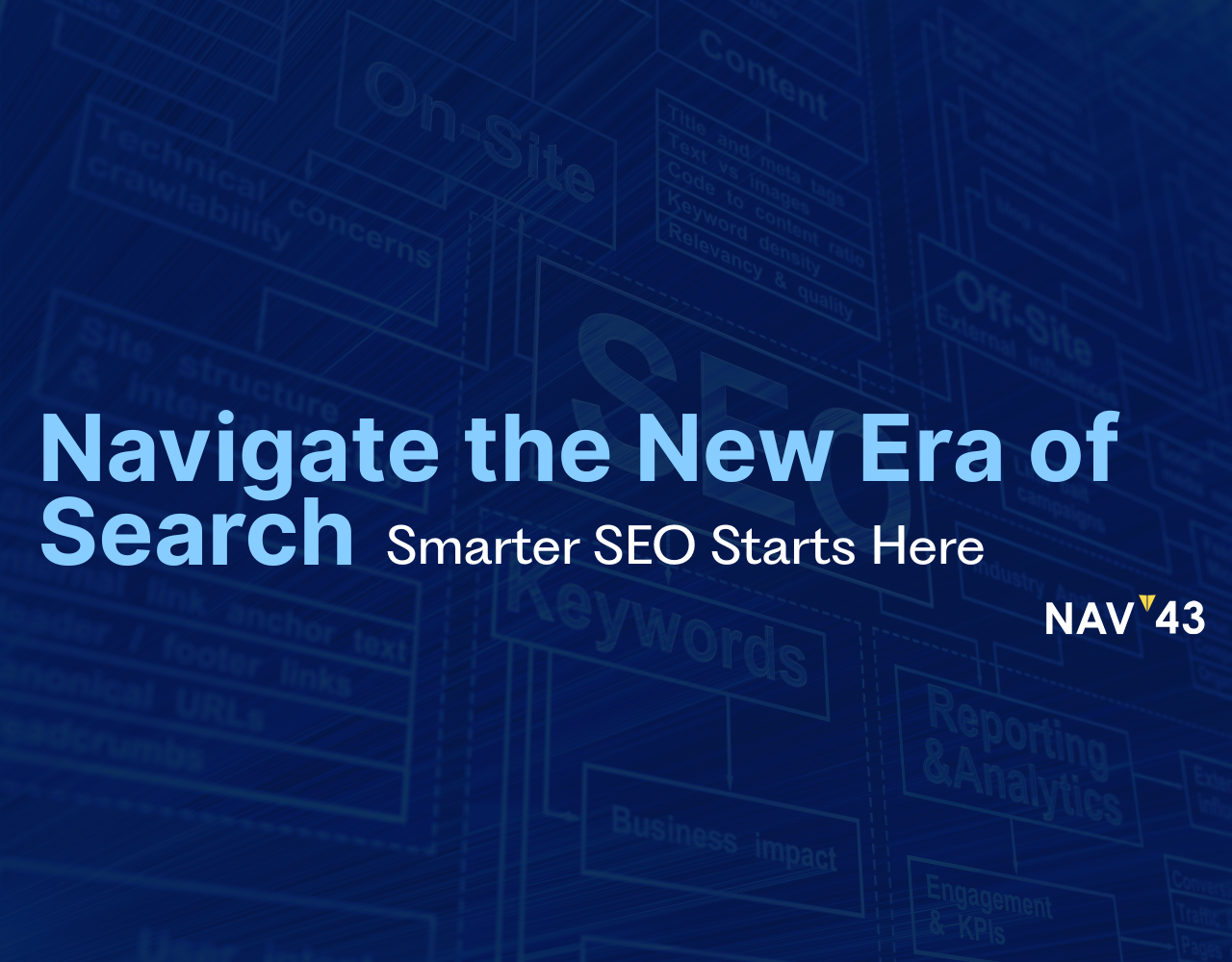
The AI-Driven Search Revolution: Why SEO Will Never Be the Same
The AI-Driven Search Revolution: Why SEO Will Never Be the Same
Introduction: A New Era for Search and SEO
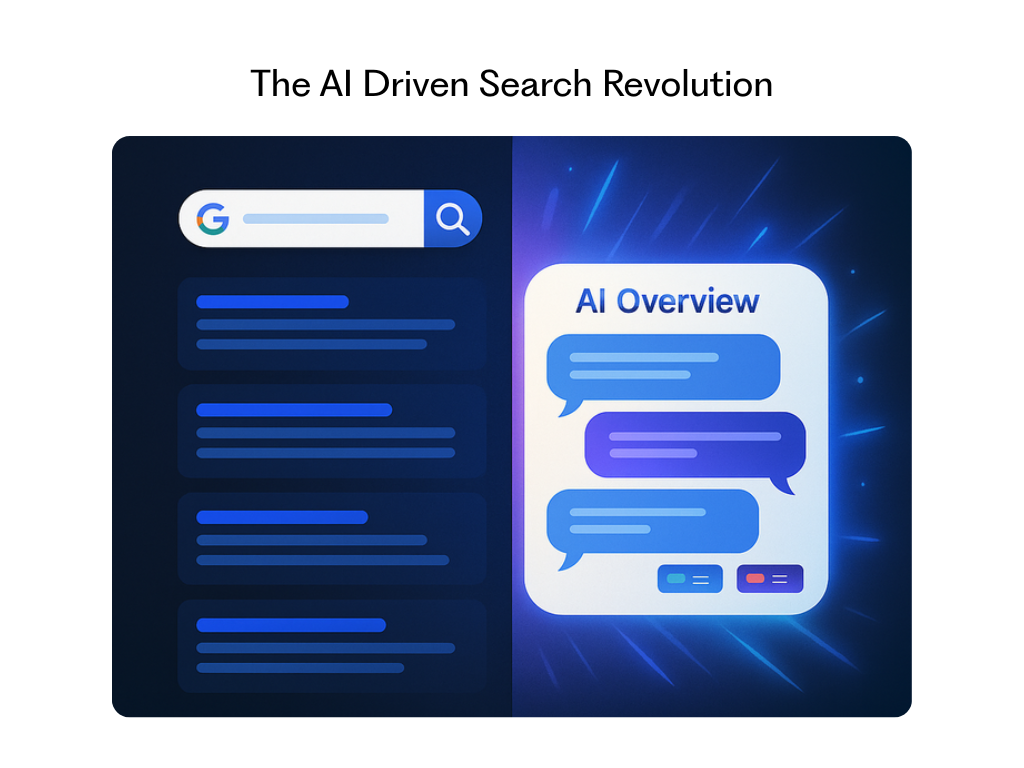
The world of search is undergoing a seismic shift. As marketing leaders in ecommerce and lead generation, you may have heard some traditional agencies claim that “it’s the same SEO as always.” Nothing could be further from the truth. AI-powered search is fundamentally transforming how people find information, and in turn, how brands must approach SEO. From zero-click searches dominating user behaviour to AI-generated answers stealing the spotlight (and clicks) from organic links, the old playbook for ranking and traffic is rapidly becoming outdated. This blog will outline why “business as usual” SEO no longer works – and what visionary brands should do about it.
We’ll explore how zero-click searches now rule the top of the funnel, why even a #1 Google ranking no longer guarantees traffic, and how concepts like “pixel rank” are replacing traditional rank tracking. You’ll learn about the technologies behind AI-driven search, from RAG (retrieval-augmented generation) to vector search, and why they mean what ranks today is not what used to rank. Most importantly, we’ll discuss how SEO strategy must adapt for AI-centric platforms like ChatGPT, Claude, and Google’s upcoming Gemini, and highlight the opportunity for those who embrace this change.
(Key takeaway: The search landscape is evolving fast. This is a thought-leadership roadmap to help you understand the shifts, rethink your SEO strategy, and stay ahead of competitors.)
The Rise of Zero-Click Searches at the Top of the Funnel
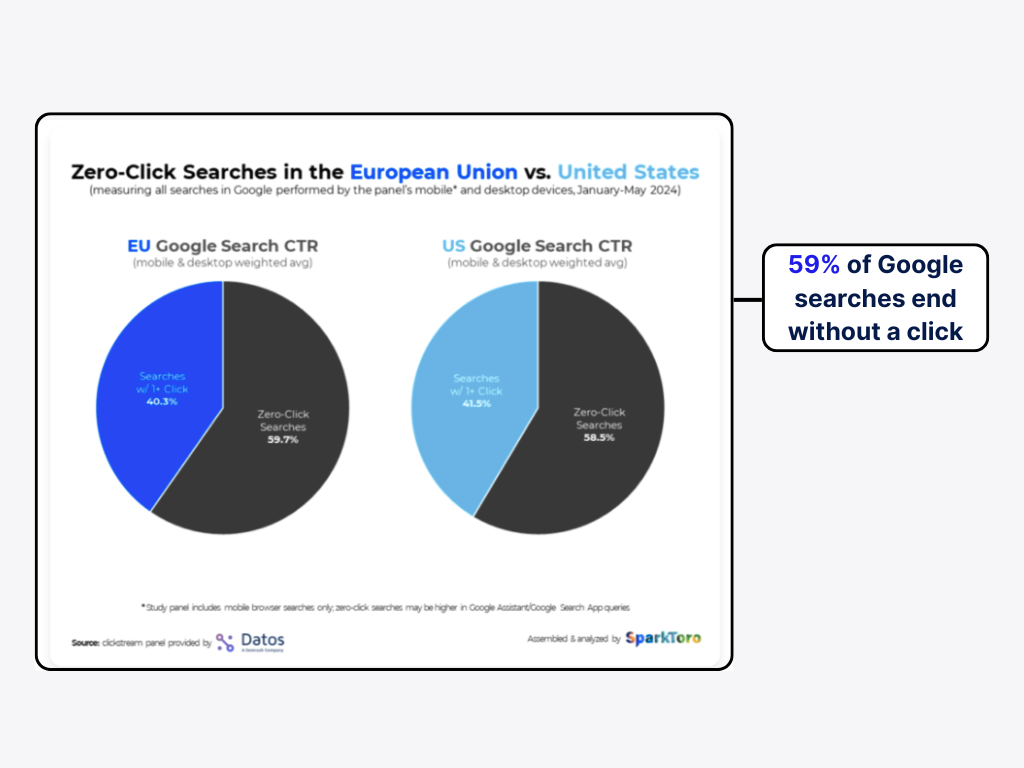
Imagine a potential customer asks Google a basic question – and gets the answer straight on the results page, without ever clicking a link. This is the new normal. Zero-click searches (queries that end without any click-through to a website) have exploded in prevalence, fundamentally changing top-of-funnel interactions. In fact, by mid-2024, over half of Google searches – around 58-60% – concluded with no click to any external site. That means the majority of users find what they need on Google itself (via featured snippets, knowledge panels, AI summaries, etc.) and don’t proceed to a publisher’s website.
Why is this happening? Google (and other search engines) are increasingly providing instant answers, including definitions, maps, flight information, AI-generated summaries, and more, directly on the results page. For users, it’s convenient – they get quick information without extra steps. However, for marketers, it presents a critical challenge: how to derive value when the user doesn’t visit your site? Top-of-funnel discovery is now often happening without a click, meaning brands must find ways to be visible and persuasive within the search results themselves.
Consider this scenario: a user searches “best dental floss picks vs floss.” Google might show an AI overview or snippet comparing the two, drawn from a source article, satisfying the query immediately. The user learns what they need and moves on. This zero-click dynamic is especially strong for informational queries (the kinds that often begin a customer journey). It underscores that SEO is no longer just about driving clicks – it’s also about providing value and building brand recognition within the search results page. (We’ll revisit strategies for this, like optimizing content for featured snippets and AI answer boxes, later in the outline.)
Stat snapshot: Roughly 59% of U.S. Google searches now end without a click. And that figure likely underestimates zero-click behaviour, since it doesn’t fully account for voice searches or queries handled entirely by Google’s own apps. Bottom line: The top of the funnel is increasingly happening on the SERP itself. Brands need to show up in those zero-click results or risk invisibility.
Why #1 Rankings No Longer Guarantee Clicks (Declining CTR)
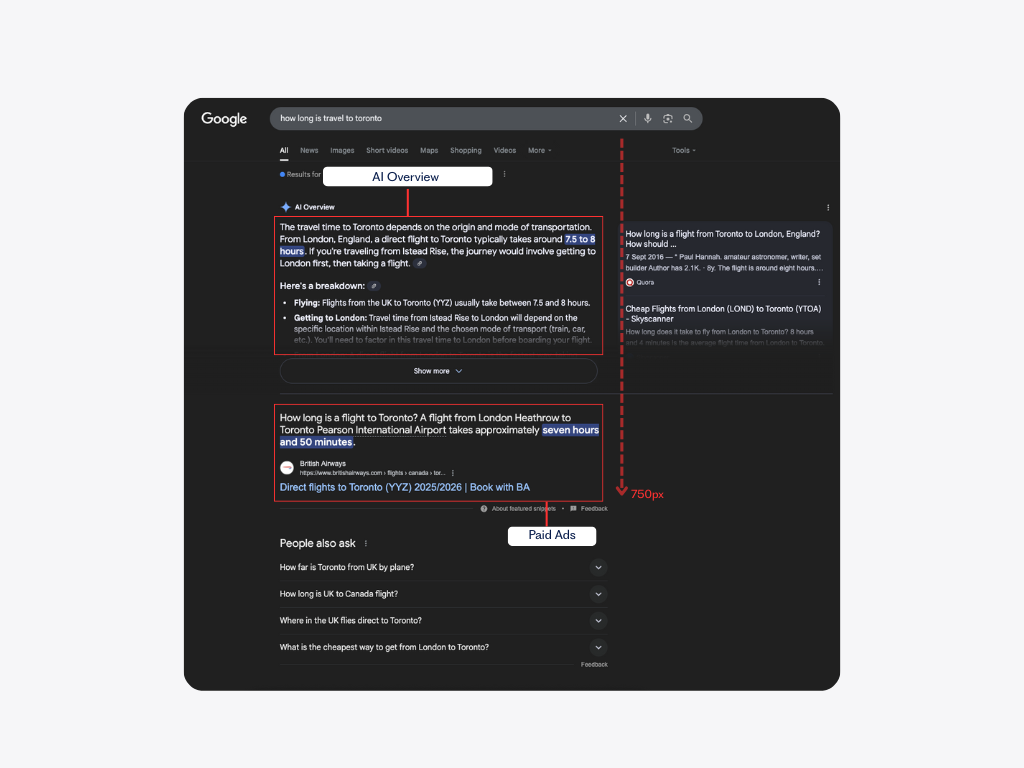
For years, the holy grail of SEO was the #1 organic ranking. Today, that #1 spot no longer delivers the traffic it once did. Click-through rates (CTR) for top organic positions have plummeted, thanks to a crowded “above-the-fold” packed with AI answers, ads, maps, and other features. Even if you’re ranking first, users might not even see your link without scrolling – or they might get their answer from an AI box and have no need to click at all.
Above: A recent study visualized how Google’s AI Overview feature impacts organic clicks. The pink bars show organic CTR for queries without an AI answer, while the teal bars show CTR when an AI Overview is present (data from 10,000 informational queries). As the months progress into late 2024, the difference becomes dramatic – when an AI answer appears, the organic CTR drops significantly.
Multiple analyses in 2024-2025 confirm this trend: when Google’s new AI-generated answer (Search Generative Experience) is shown, the top organic result loses roughly one-third of its clicks on average. One large-scale study by Ahrefs found that the #1 result’s CTR is 34.5% lower, on average, for queries with an AI answer box compared to those without. In practical terms, if you might have expected ~7% of searchers to click your first result before, that could drop to ~2-3% when an AI summary is stealing attention. Similarly, other reports found 15-20% declines in organic clicks even when rankings stayed constant – a clear sign that something above the results is siphoning user attention.
It’s not just AI snapshots causing this. Paid ads and rich snippets also crowd the top of the page. For example, on mobile screens, a combination of 4 sponsored ads, a map pack, and a featured snippet can push the first organic listing far below the initial view. The result? Users often have to scroll a lot to find the traditional results, if they bother to scroll at all. In short, being “#1” in the old sense doesn’t guarantee visibility or clicks in the new SERP landscape.
One media site, MailOnline, revealed a shocking datapoint: when Google’s AI overview was present for their news queries, their organic CTR dropped by over 50% – from ~13% to ~5% on desktop, and an even steeper drop on mobile. While that’s an extreme case, it highlights the new reality: organic traffic can evaporate even though your SEO rankings haven’t changed, because the way people interact with the results page has changed.
The key takeaway for marketers is sobering: you can be doing “everything right” in terms of traditional SEO – great content, high rankings – and still see less traffic. We need to redefine what success looks like (and how we measure it). This is where concepts like “pixel rank” come in, and why we must focus on actual on-screen visibility rather than just the old ranking positions.
How AI-Powered Search Is Rewriting the Rules (RAG, Vectors & Real-Time Results)
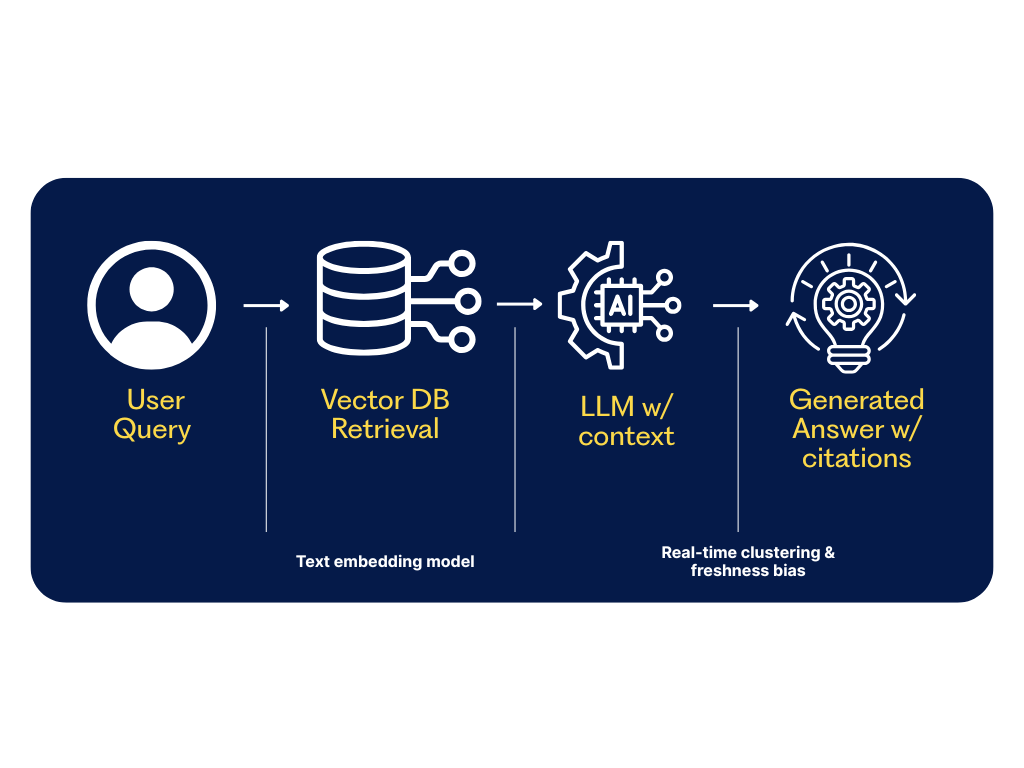
Why are we seeing such dramatic changes in search behaviour? A big reason is how AI-driven search works under the hood. Unlike traditional search, which primarily matched keywords to pages and served a list of links, AI search engines use advanced techniques like retrieval-augmented generation (RAG), vector similarity search, and real-time content clustering to formulate answers. The result is a completely different approach to deciding which content to show the user.
Retrieval-Augmented Generation (RAG) is at the heart of many new search models. In simple terms, RAG means the AI doesn’t rely solely on a pre-trained index; it actively retrieves relevant snippets of content from multiple sources in real time and then composes an answer. For example, Google’s AI Overviews will pull in facts from various web pages (not just the top result) to build a comprehensive answer. Similarly, Bing’s ChatGPT-based search and other tools use vector search to find semantically relevant passages across the web, even if those passages aren’t from the traditionally top-ranked pages. In essence, the AI can cherry-pick the most pertinent information from anywhere, rather than assuming the highest-ranked page has all the answers.
This means what “ranks” in an AI answer box may not mirror the traditional rankings at all. The AI might take a paragraph from result #5, a definition from result #12, and an insight from a niche blog that didn’t rank at all on page 1 – if those pieces together answer the query well. It’s a dynamic, on-the-fly aggregation of content. As a result, the content that gets visibility now is more about relevance and context than about old-school SEO ranking factors.
Some key differences in AI-driven search to note:
- Comprehensive Answers vs. 10 Blue Links: AI search aims to give a single, comprehensive response instead of a list of options. Google’s SGE “snapshots” and Bing’s chat results often synthesize info from many pages. They don’t just pull from the first couple of results; they might tap into related topics and sub-questions to provide a rich answer. This means your content might appear as part of an AI answer even if it wasn’t a top result, if it’s semantically relevant and authoritative on a subtopic.
- Above-the-Fold Dominance: These AI answers usually appear at the very top and can be large, interactive units (with images, cards, and citations). They often occupy the entire above-the-fold area. The traditional results are pushed down (hence the pixel rank issue). For SEO, this implies that being featured within the AI overview is gold, since that’s what users see first. Conversely, if you’re not in that overview, you may be almost invisible until it’s scrolled past.
- Personalization & Context: AI-driven search has the potential to be more personalized and context-aware. Large language models can take into account a user’s phrasing, location, or even past interactions to tailor answers. Google has hinted at “AI Modes” that will adjust results based on user behaviour and preferences, making search more conversational and context-rich. In other words, different users might get different AI-generated answers for the same query, depending on real-time factors. This is a big shift from the one-size-fits-all SERP of the past.
- Real-Time Information & Clustering: Traditional SEO often lagged with fresh info (e.g., a new page might take time to rank). AI search, using real-time retrieval, can surface very recent information instantly if the AI deems it relevant. It can also cluster content by intent – for instance, an AI might break down a broad query into sub-answers, each drawn from a different source that best addresses that sub-topic. This means content freshness and specificity are more important than ever, since the AI will gravitate toward the most up-to-date, on-point pieces for inclusion.
All these factors contribute to an overarching reality: the determinants of visibility in search have broadened. It’s not just “Did I use the right keywords and get enough backlinks to rank #1?” Now it’s also “Is my content structured in a way an AI can easily digest? Do I cover the topic in depth so I might be quoted? Is my info current? Do I have schema or data that an AI can pull?” The algorithms and mechanisms weighting these factors are new and evolving rapidly.
For example, Google’s own data shows that AI overviews appeared in about 12-13% of all search queries in late 2023 (during the Search Labs experiment), and that number was expected to grow. Additionally, Google announced in 2024 that people had already used the experimental AI search billions of times, and they began rolling it out to hundreds of millions of users (with a goal of reaching over a billion users by the end of the year). In short, AI-driven results are quickly becoming a regular part of search for a huge chunk of queries. The traditional SEO ranking order is no longer the sole gatekeeper to getting in front of searchers, but you have to play by the new rules to be included.
SEO in the Age of ChatGPT, Claude, and Google Gemini
Not long ago, “SEO” was practically synonymous with “optimizing for Google Search.” Now, we must think broader. AI chatbots and assistants are becoming search portals in their own right. Tools like OpenAI’s ChatGPT (with web browsing or plugin capabilities), Anthropic’s Claude, Bing Chat, and emerging models like Google’s Gemini are enabling users to ask questions and get answers without ever using a traditional search engine interface. This fragmentation of search means your audience could discover (or miss) you on entirely new platforms.
Consider the stats: By 2024, over 50% of Gen Z users were regularly using AI tools like ChatGPT for search purposes. ChatGPT itself was reportedly handling around 37 million searches/questions per day by late 2024. – a huge volume (equivalent to about one-third of DuckDuckGo’s total search traffic). While Google still dwarfs that (with billions of daily searches), it’s telling that such a significant number of queries are shifting to AI assistants. And with Google’s own AI features (SGE/AI overviews) rolling out widely, the very nature of “a search query” is changing for everyone.
So, what does it mean to “do SEO” for these AI platforms? It’s a question many are grappling with, but some principles are emerging:
- Ensure Your Content Is Accessible to AI: ChatGPT and Claude don’t have an index like Google’s, but they rely on underlying data. For instance, ChatGPT’s Bing integration means that having strong content that ranks on Bing or is referenced on the open web can help you be included in ChatGPT’s answers. Similarly, Google’s Gemini (likely powering future AI search) will use Google’s index plus real-time retrieval. That means all the traditional on-page best practices (clean site architecture, proper indexing) still matter – if the AI can’t fetch your content when needed, you’re out of the game.
- Aim to Be a Cited Source: When ChatGPT or SGE provide answers, they often cite sources or link out (especially to high-quality sources). This is a new kind of ranking: instead of being ranked #1 in a list of 10, you want to be one of the 3-5 sources cited in an AI answer. That could mean writing content that directly answers common questions, in a concise and authoritative way, so that the AI finds it valuable. It also means maintaining high E-E-A-T (Experience, Expertise, Authority, Trustworthiness), because these models favor trusted sources to reduce the risk of misinformation.
- Leverage Structured Data and APIs: Some AI search tools might allow direct integration. For instance, businesses are already exploring providing data feeds to AI chatbots (for real-time info like stock, inventory, etc.) and using schema markup so that AI algorithms can easily parse their content. Google’s guidelines suggest using schema (FAQ, HowTo, etc.) to help their AI understand and feature your contentnav43.com. Forward-looking SEO might involve ensuring your site’s facts and offerings are machine-readable to the extreme – think in terms of AI-ready content.
- Prepare for Personalization: AI assistants can tap into personal data. We might see, for example, a scenario where Claude knows you prefer eco-friendly products, so it tailors its answers about “best running shoes” to emphasize sustainable brands. This isn’t mainstream yet, but it’s on the horizon. SEO strategy should therefore consider user segments and contexts more. In the content you create, be aware of different intents and angles – the AI might choose the content that best fits the specific user’s implied needs. One user’s AI result might favour one aspect of your content, another user’s might quote a different section.
In essence, SEO is expanding into AEO – Answer Engine Optimization. We need to think about how an answer engine will interpret, use, and present our content. It’s not just about Google’s ranking algorithm anymore; it’s about a variety of AI algorithms all seeking the best, most relevant content for their users’ queries.
Relevant stat: By early 2025, Google reported users were more satisfied with results when AI overviews were present, and that search engagement was up in those cases. This suggests that people are embracing AI-driven search results. Additionally, Google’s Gemini promises even more advanced AI integrations (e.g. multi-modal search, deeper reasoning). The train has left the station – AI-based search is here and growing. Brands that optimize for these new channels will capture audiences that others miss.
Pixel Rank: Measuring Visibility in an AI-Driven SERP
How often is your #1 ranking page essentially invisible unless the user scrolls? In the AI-driven SERP, this is a common scenario. This has given rise to a new metric: Pixel Rank. Unlike the traditional rank position (1, 2, 3, etc.), pixel rank measures how far down the page (in pixels) your listing appears. In other words, it asks: when a user enters a query, how many pixels must they scroll to see your result? This is a far more realistic gauge of visibility when SERP features vary wildly in size and placement.
In today’s Google results, a “#1 organic result” might actually be hundreds of pixels down, below an AI answer box, ads, a local pack, and more. For example, SEO researchers found that for competitive head terms like “hotels,” the first organic link can show up only on the second screenful on desktop – and on mobile, it might be entirely out of view until multiple scrolls. That’s why pixel rank tracking is emerging as a more meaningful metric than traditional positions. It reflects what users actually see without scrolling, which is crucial for understanding real-world impact.
To adapt, savvy SEO teams are using tools that track pixel rank and “share of screen”. For instance, one can calculate the percentage of the first viewport occupied by your content (sometimes called “share of squares” in the context of AI answer boxes). If your result is consistently appearing, say, 1200 pixels down, it means virtually all users have to scroll significantly to find you, which likely correlates with low CTR. By monitoring this, you can identify which keywords or pages are most impacted by SERP features and adjust strategy (like targeting different queries, or optimizing for those features).
The rise of pixel rank underscores a broader point: our metrics for success in SEO need to evolve. Instead of celebrating a #1 ranking blindly, we now ask, “Are we above the fold? Are we featured in the AI summary? How much screen real estate do we control on the results page?” These questions get closer to measuring true visibility in the AI era. In short, pixels beat positions as a yardstick for modern SEO performance.
Embracing the Opportunity: How AI Shake-Up Can Benefit Bold Brands
All these changes may sound daunting, but they also spell opportunity for those willing to adapt. When the rules of the game change, new winners can emerge. Here are some silver linings and advantages to seize in the AI-driven search era:
- First-Mover Advantage in AI Visibility: Many of your competitors (especially those stuck in the “it’s the same as always” mindset) will be slow to adjust their SEO approach. This gives you a chance to leapfrog them in visibility. For example, if you’re the first in your space to create content worthy of AI citations, you might get featured in AI overviews even above sites that traditionally outrank you. In some cases, your page might not be #1 organically, but it still gets the spotlight in an AI answer box – effectively stealing attention from the higher-ranking competitor. This is a real chance to level the playing field or even outperform larger competitors by being agile and forward-thinking.
- Owning the Zero-Click Experience: While zero-click searches mean fewer direct website visits, think of it this way: If a user doesn’t click any site, you want your brand to be the one that still delivers the answer. For instance, if an AI summary answers a question using your blog’s insights (and cites YourBrand as the source), you’ve achieved a branding win. The user got value from you, even without clicking. This can build trust and awareness, which might influence them down the line. In effect, content can act as an advertisement for your expertise. Brands that master zero-click content (delivering value straight on the SERP) will turn these “lost” clicks into micro-wins for reputation and visibility.
- Reinventing KPIs and Success Metrics: The shift to AI search allows innovative brands to redefine success. Rather than obsessing solely over organic traffic volume, you can start tracking metrics like “presence in AI results”, share of voice in featured snippets/overviews, or engagement with interactive SERP features. This broadens the value SEO delivers. For example, if your content is frequently appearing as a cited source in AI answers, that might correlate with more branded searches or direct traffic later (as users remember your name). Early adopters can develop these new KPIs and demonstrate value in ways competitors aren’t even measuring yet.
- Content Strategy Aligned with Customer Journey: AI answers tend to handle top-of-funnel queries, but often they encourage follow-up or deeper exploration. If your content is part of that initial answer, you’re in a great position to capture the user later in the journey. Perhaps the user didn’t click on the zero-click answer, but the AI overview suggested a next step or the user eventually asks a more specific question where your site can get the click. By anticipating follow-up questions and creating content for every stage (TOFU, MOFU, BOFU), you ensure that even if the first interaction is via an AI blurb, subsequent interactions lead the user to your site or offerings. In short, you can guide the AI-influenced funnel toward your brand.
- Competitive Edge Through Experimentation: The AI search landscape is new and not fully charted. Brands willing to experiment – whether it’s testing different content formats (like FAQ schemas, short fact snippets, or even providing AI-specific content feeds), or using new tools to monitor how their content is used by AI – can find untapped tactics. For example, some companies are now actively monitoring how often their content appears in AI outputs and optimizing for that. This is akin to the early days of featured snippets: those who cracked the code early reaped disproportionate rewards. Today, that “code” is getting content into AI results. If you succeed, you gain an edge that can last until competitors catch up (by which time you may have moved on to the next innovation).
In summary, yes, AI is disrupting SEO, but disruption creates openings. The brands that view these changes not as doom and gloom, but as a chance to innovate, will lead the pack. There’s a huge opportunity to capture audience attention in new ways and steal a march on slower competitors. The key is to evolve your strategy now, while many others are still in denial or confusion.
(Remember: every major shift in digital – from mobile-first to social media to this AI wave – has winners and losers. The winners are those who embrace the change early.)
Future-Focused SEO: Strategic Shifts for the AI Search Era
To thrive in this new landscape, your SEO strategy needs a refresh. Below is a strategy checklist with recommendations for adapting to AI-driven search. Implementing these will help ensure your content not only survives, but excels in the era of AI-overviews and answer engines:
- Optimize Content for AI Discovery and Summarization: Craft your content in a way that makes it easy for AI systems to digest and use. This means answering common user questions directly and succinctly within your content. Consider incorporating an FAQ section or a clear Q&A format in relevant pages. Also include concise summaries or conclusion paragraphs that an AI might lift as a direct answer. The goal is to produce semantically rich, well-structured content that an AI overview would deem worthy of quotingnav43.comnav43.com. Write with natural language and context in mind – AI thrives on context, so cover the “who, what, why, how” around your topic thoroughly.
- Implement Structured Data and Schema Markup: Use schema markup (FAQ schema, HowTo, Product, etc.) to explicitly highlight key information on your pagesnav43.com. Structured data makes it easier for AI algorithms (and search engines in general) to understand the content and pull it into rich results. For example, marking up a Q&A can increase the chance of being included in an AI Q&A style result. Google’s own documentation indicates that structured data can improve how your content is featured in AI overviews. Beyond schema, ensure your HTML is clean and semantically organized (headings, lists, tables where appropriate) – as these formatting elements often get picked up in featured snippets and AI resultsnav43.com.
- Focus on E-E-A-T and Authority: In an AI-driven world, the machines try extra hard to fetch reliable information (to avoid the dreaded “AI hallucinations”). Content that demonstrates expertise and trust is more likely to be selected as a source. So, double down on authoritative content. This includes citing sources within your content, showcasing author credentials, getting backlinks from respected sites, and keeping content factually accurate. Studies indicate that AI-generated answers with citations to trusted sources increase user trust, so you want to be among those trusted sourceslinkedin.comlinkedin.com. If you haven’t already, perform an E-E-A-T audit of your site: Is it clear why your brand/page is an expert on this topic? If not, bolster it.
- Keep Content Fresh and Updated: AI retrieval systems prioritize up-to-date info, especially for queries where information changes (news, trends, technology, etc.)linkedin.comlinkedin.com. Make a schedule to revisit high-performing content and update it regularly with new insights, data, or examples. Even updating the timestamp can help signal freshness. Also, if there are emerging questions in your industry (e.g., new jargon, new user queries appearing), create content for those quickly. Being the first to answer a new question not only can rank you well on Google, but also put you on the radar for AI systems looking for the latest information.
- Pursue Featured Snippets and “Citation Wins”: Many traditional SEO tactics still pay dividends in the AI era. Optimize for featured snippets, as they often serve as the basis for AI answers or at least get displayed alongside themnav43.com. This means identifying common question queries in your niche and tailoring content to answer them clearly (often in a paragraph or bulleted list format). Additionally, think of citation wins – times when your brand is mentioned as an authority. For instance, getting your data or quote included in someone else’s article that might be used by AI can indirectly get you cited. In other words, content distribution and PR can contribute to SEO by proliferating your authoritative voice across the web, increasing the likelihood that AI pulls from your perspective.
- Monitor and Adapt (New Metrics): Start tracking how your content is performing in the context of AI search. This could include keeping tabs on referral traffic from Bing (which might indicate Bing Chat usage), looking at Google Search Console for changes in impressions vs. clicks (signs of zero-click), and even qualitatively checking if your content is appearing in SGE snapshots (some SEO tools and plugins are emerging to help with this). Also monitor your pixel rank for key queries – see how often you’re above the fold. Use this data to iterate your strategy: if certain content isn’t getting visibility, maybe target different questions or formats. If some pages are consistently cited by AI, analyze why and apply those lessons elsewhere. Flexibility and continuous learning are key – the AI algorithms evolve fast, and so must you.
Finally, don’t neglect the fundamentals amid all the new tactics. Site speed, mobile-friendliness, and user experience still matter. After all, if an AI or search snippet sends a visitor your way, you need to delight them. Google’s algorithms (AI or not) will continue rewarding positive user experiences and fast, accessible content. Think of it as shoring up your foundation while you build on these new frontiers.
Conclusion: Adapt Now or Be Left Behind
The advent of AI-driven search is the biggest shake-up to SEO in at least a decade. For marketing leaders and founders, the message is clear: evolve your SEO strategy or risk losing ground. The data doesn’t lie – user behaviour is changing, and the search platforms are changing with it. The old tricks and assumptions won’t guarantee results like they used to. But with change comes opportunity. By understanding these trends and acting on them, you can not only protect your organic visibility but palso otentially surpass competitors who stick to the status quo.
At NAV43, we’ve positioned ourselves at the forefront of this transformation. We believe that the future of search isn’t just about ranking number one anymore – it’s about ensuring your content becomes part of the entire AI ecosystem. Our approach to SEO has already integrated these AI-era principles: from creating content that speaks to humans and machines alike, to developing new metrics for success (like pixel rank and share-of-voice in AI answers). We view ourselves not just as SEO consultants, but as navigators for the new search landscape – guiding brands through uncharted waters with a forward-looking, experimental mindset.
If your current agency or team is telling you that “nothing’s changed” or treating AI as a minor add-on, you deserve to hear the other side of the story. The brands that thrive will be those that anticipate and embrace the new reality of search. It’s time to ask tough questions: Is your SEO strategy ready for an era of zero-click results and AI-curated answers? Are you prepared to optimize for algorithms that learn and interpret rather than just index keywords?
Our invitation: Let’s talk about what this AI-driven search revolution means for your business specifically. Whether you run an e-commerce brand looking to maintain visibility for product queries or a lead-gen company aiming to capture prospects researching solutions, there are concrete steps to take now to secure and grow your organic pipeline. Rethink SEO with us – the stakes are high, but so are the rewards for getting it right.
Let’s embrace the future of search – it’s already here. By staying visionary and adaptable, we can ensure your brand is not just present but thrives in the new AI-driven search landscape.
